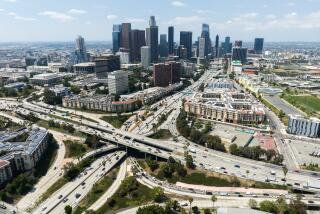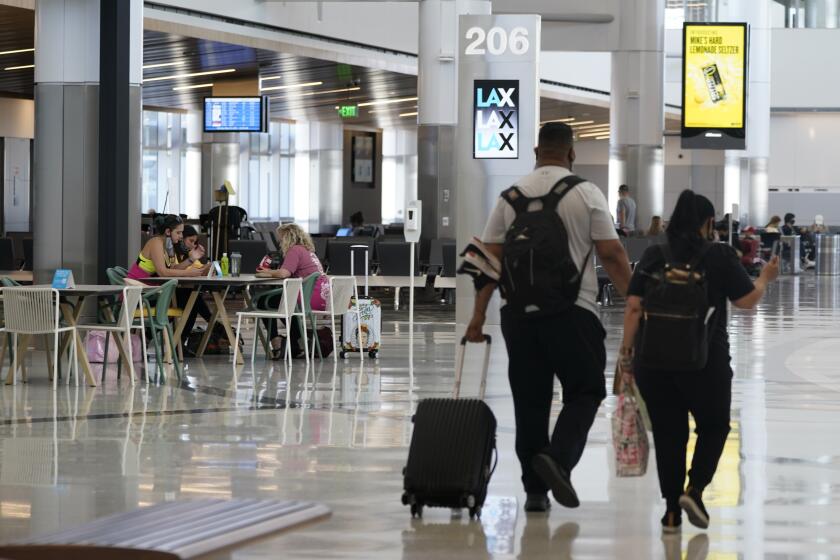Automated Trolleys May Be OKd for Century Line
- Share via
The Los Angeles County Transportation Commission may reverse itself today on a much-debated issue--one that could reshape the future of local mass transit--by choosing to build the nation’s first fully automated, driverless trolley system down the middle of the new Century Freeway.
It is a controversial proposal because it would mean that the first three segments of the county’s new multibillion-dollar mass-transit system--the RTD’s Metro Rail subway and the commission’s Century Freeway and Los Angeles-to-Long Beach trolley lines--all would have incompatible rail cars.
And the proposal comes after the commission has ordered more than $20 million worth of manually operated cars for the Century line that would have to be mothballed for years or peddled to other cities.
A change to automated cars raised questions when first presented to the full Transportation Commission last month, but it now appears that enough doubts have been resolved to win most commissioners’ support.
Proponents say the driverless system is a prudent investment that will upgrade passenger service on the $344-million Norwalk-to-El Segundo trolley line by permitting smaller trains to run far more frequently. It also will reduce long-term trolley operating costs by eliminating highly paid motormen and be more aesthetically pleasing, proponents contend.
But critics say introducing a third transit technology typifies planning that will produce a costly, difficult-to-use and disjointed rail system. And some officials worry that the different systems are bound to discourage riders who will have to change from train to train.
“In an effort to move things along, we’ve erred maybe on the side of (having too many) different modes,” said County Supervisor Ed Edelman, who is among officials voicing concern over the proposal. “We should try to get (a system in which) people can stay on one train to get where they want to go.”
Until recently the commission, in planning its 100-plus-mile system, intended to use manually operated cars that receive power from overhead wires. This is the type of trolley to be used on the Los Angeles-to-Long Beach line currently under construction.
However, several commissioners now say that, at least for the Century Freeway line, they are convinced of the merits of driverless cars, ones that would pick up power from an electrified rail at ground level.
“What turned me around was other successful systems,” said Commissioner Jacki Bacharach, referring to driverless trolleys used in Vancouver, Canada, London and Lille, France. Bacharach, an influential commissioner who chairs the rail construction committee, and other commission officials have traveled at public expense across Europe, Canada and the Far East in recent years to inspect various rail systems.
Bacharach said she has learned that the new automated systems are popular with riders and that fare-box revenues make it possible to recover big chunks of the operating costs.
“(They have) worked astoundingly well,” she said.
Other officials fear a proliferation of different rail systems will exacerbate the difficulty of linking one mass transit leg to another. On the rail lines currently approved, a commuter going from the west San Fernando Valley to Los Angeles International Airport would have to ride four lines and transfer three times.
Criticism From Katz
“As long as they design it so you have to get on and get off, it’s never going to be user-friendly,” said Sepulveda Democrat Richard Katz, who chairs the state Assembly Transportation Committee. “This is a system that is bureaucrat-friendly, technology-friendly but not user-friendly.”
Wendell Cox, an Illinois-based transit consultant who formerly represented Los Angeles Mayor Tom Bradley on the commission, said studies have shown that riders are more sensitive to the time they spend waiting for transfers than any other aspect of using public transit.
“With a third technology, clearly you create a situation where you no longer have the ability to make” direct service connections, said Cox.
But proponents of the Century automated system say the transfer issue is no longer relevant. The decision to require transfers was made years ago for sound operational and technical reasons, they argue, and riders have been willing to transfer from train to train in other cities.
Since the lines will not be interconnected, there is no reason to be wedded to a single technology, automation proponents say.
Some commissioners argue that the real problem is having chosen an outdated system for the Los Angeles-Long Beach line. Unlike the automated system, those trolleys will run at road level and mix with street traffic at intersections and on boulevards in several areas.
Describing the Long Beach system as “an 1890s railroad,” Commissioner Walter King said that, with the Century Freeway line, “we are (not going to repeat) what I think are the mistakes we’ve already made.”
Other commissioners argue that the novelty of the high-tech system will lure Los Angeles’ auto-loving commuters out of their cars. “The fact that it will be the first one in the United States is enough to make them try it,” said Ray Grabinski, a commissioner from Long Beach.
But some are not so sure.
“This is a first-time concept. . . . If everyone thinks that is going to be universally accepted, you’re dead wrong,” County Supervisor Pete Schabarum, the Transportation Commission chairman, told commissioners recently.
A key argument for the automated system is that it will reduce labor costs by eliminating motormen and permitting lower-paid attendants to roam the trains.
But, based on the experience in other cities, Cox said transit unions will likely organize the transit attendants and gradually boost their pay. “I would question whether the labor savings is really going to occur,” he said.
$50 Million in Added Costs
If an automated system is chosen, it will commit the commission to more than $50 million in added costs for the Century line and future extensions to Marina del Rey and the South Bay, according to commission reports.
But proponents argue that when the projected operating savings over 30 years are deducted from the higher construction costs, the true added cost of the automated system is relatively small.
Maintenance is another issue. Some Southern California Rapid Transit District officials, who are supposed to operate the rail system, have privately expressed reservations about adding another technology. They note that the transit district has struggled with maintenance problems because its huge bus fleet includes many different models--a situation they would not like to see repeated in the rail system.
But the commission’s director of transit design, Ed McSpedon, said maintenance problems will be minimized by making many components on the cars interchangeable.
Union Involvement
The push to adopt the automation proposal figures into multiyear labor talks now under way between the RTD and its employee unions. The RTD bus drivers union will represent trolley and Metro Rail subway motormen, and those job descriptions and pay rates are a key part of this year’s negotiations.
“If you design a system that requires (no motormen), it may put the RTD in a stronger (bargaining) position,” McSpedon said, “rather than let the labor negotiations lead the technology.”
Among those pulling for the automation proposal is Don Camph.
Camph is a former top commission executive turned lobbyist who represents MATRA, a French firm that builds automated trolley systems and hopes to win a Century Freeway contract. Camph helped arrange trips for commissioners to view MATRA’s system in Lille, France, and once accompanied a contingent of local officials on a European trip.
He also serves as executive director of the El Segundo Employers Assn., a coalition of some of the largest employers in the county who have a keen interest in an already approved western extension of the Century line.
Employer Groups’ Role
The employer group members, including Chevron USA, Hughes Aircraft Co., Northrop Corp., TRW Inc. and their executives have contributed nearly $150,000 in the last five years to campaign committees of Mayor Bradley and the five county supervisors, who appoint a majority of the county Transportation Commission members.
Some of those firms have been seeking a more costly elevated configuration for the El Segundo extension, rather than street-level sections currently incorporated into the manually operated design.
The employers group has offered to negotiate some cost sharing, but choosing an automated system may weaken the commission’s bargaining position because it would eliminate any street-level option. Preliminary cost analyses prepared for the commission have assumed the public would have to pay all of the added costs.
Camph acknowledged talking “extensively” to commission officials about the automated system, but he said the “merits of the argument” have carried the day rather than his connections or the influence of his clients. “I think the sense of the people in my association was (that switching to automated) would be great,” he said. “But it was not something (they) wanted to use a lot of chits on.”
Bacharach acknowledged that Camph has been active, but she said others, including citizen activists who advise the commission, were more influential in pushing for the automated technology.
INCOMPATIBLE RAIL SYSTEMS
Incompatible technology is causing controversy over the intersecting Century Freeway and Long Beach-to-Los Angeles lines. Critics say the differing technologies in powering the trolleys will increase construction costs, complicate maintenance and preclude the chance of linking service.
OVERHEAD POWER
Long Beach line, now under construction, will use overhead power system with cars manually controlled by operators.
THIRD RAIL POWER
Century Freeway line would use driverless, automated cars with power drawn from a track-level, electrified third rail.
Source: Los Angeles County Transportation Commission
More to Read
Sign up for Essential California
The most important California stories and recommendations in your inbox every morning.
You may occasionally receive promotional content from the Los Angeles Times.










